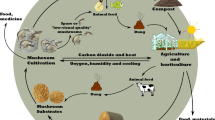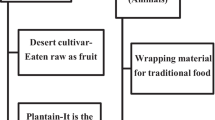Abstract
Burma reed (Neyraudia reynaudiana), a giant C4 grass, was included in substrate at the rates of 0, 20, 40 and 66 % to partially or wholly substitute sawdust and cottonseed hulls to evaluate its suitability for Pleurotus eryngii cultivation. Inclusion of 20 and 40 % Burma reed did not significantly affect linear mycelial growth, dry matter loss, spawn run period and fructification, and achieved high fruiting body yields and biological efficiency of 336.67 g/bag, 67.33 % and 342.15 g/bag, 68.43 %, respectively, which were not significantly different from 350.08 g/bag to 70.02 % obtained from the control substrate. Enzyme assay revealed that on the mixed substrates laccase and manganese peroxidase activity were significantly enhanced, but cellulase was significantly reduced in the middle stage of incubation as compared with the control substrate. Even on Burma reed substrate without sawdust and cottonseed hulls, fruiting body yield (313.56 g/bag) and biological efficiency (62.71 %) were satisfactory, although significantly lower than that on the control substrate. Therefore, Burma reed was a promising potential substrate for P. eryngii production to largely substitute sawdust and cottonseed hulls.




Similar content being viewed by others
References
Stajic M, Vukojevic J, Duletić-Lauševic S (2009) Biology of Pleurotus eryngii and role in biotechnological processes: a review. Crit Rev Biotechnol 29(1):55–66
Rodriguez-Estrada AE, Royse DJ (2007) Yield, size and bacterial blotch resistance of Pleurotus eryngii grown on cottonseed hulls/oak sawdust supplemented with manganese, copper and whole ground soybean soybean, soya bean, or soy pea, leguminous plant (glycine max, G. soja, or soja max) of the family Leguminosae (pulse family), native to tropical and warm temperate regions of Asia, where it has been. Biores Technol 98:1898–1906
Liang ZC, Wu CY, Shieh ZL, Cheng SL (2009) Utilization of grass plants for cultivation of Pleurotus citrinopileatus. Int Biodeterior Biodegrad 63:509–514
Ohga S, Royse DJ (2004) Cultivation of Pleurotus eryngii on umbrella plant (Cyperus alternifolius) substrate. J Wood Sci 50:466–469. doi:10.1007/s10086-003-0574-2
Royse DJ, Rhodes TW, Ohga S, Sanchez JE (2004) Yield, mushroom size and time to production of Pleurotus cornucopiae (oyster mushroom) grown on switch grass substrate spawned and supplemented at various rates. Biores Technol 91:85–9113
Weng BQ, Zheng H, Wang YX, Jiang ZH (2006) Advance in nutrient transformation in edible fungus cultivated with herbage and the main regulation technology. Rev China Agric Sci Technol 8(3):40–46
Lin XS, Lin YQ, Yu YR, Chen TQ (2007) A study on Pleurotus eryngii factorized-cultivation of Juncao. J Guangxi Acad Sci 23(2):95–96
Lazarides M (1980) The tropical grasses of Southeast Asia (excluding bamboos). In: Cramer J (ed) Phanerogamarum maographiae tomus XII. Vaduz, Germany, p 225. ISBN 3-7682-1255-6
Goering HK, PJ Van Soest (1970) Forage fiber analysis (apparatus, reagents, procedures and some applications), agriculture handbook no.379. ARS-USDA, Washington
Chang ST, Milles PG (1989) Edible mushroom and their cultivation. CRC press, Florida
Ghose TK (1987) Measurement of cellulase activities. Pure Appl Chem 59(2):257–268
Heinzkill M, Bech L, Halkier T, Schneider P, Anke T (1998) Characterization of laccases and peroxidases from wood-rotting fungi (Family Coprinaceae). Appl Environ Microbiol 64(5):1601–1606
Baldrian P (2005) Fungal laccases-occurrence and properties. FEMS Microbiol Rev 30:215–242
Elisashvili V, Penninckx M, Kachlishvili E, Tsiklauri N, Metreveli E, Kharziani T, Kvesitadze G (2008) Lentinus edodes and Pleurotus species lignocellulolytic enzymes activity in submerged and solid-state fermentation of lignocellulosic wastes of different composition. Biores Technol 99(3):457–462
Martinez AT (2002) Molecular biology and structure–function of lignin degrading heme peroxidases. Enz Microb Technol 30:425–444
Perez-Boada M, Ruiz-Duenas FJ, Pogni R, Basosi R, Choinowski T, Martinez MJ, Piontek K, Martinez AT (2005) Versatile peroxidase oxidation of high redox potential aromatic compounds: site-directed mutagenesis, spectroscopic, crystallographic investigation of three long-range electron transfer pathways. J Mol Biol 354:385–402
Couto SR, Sanromán MA (2005) Application of solid-state fermentation to ligninolytic enzyme production. Biochem Eng J 22(3):211–219
K¨ues U, Liu Y (2000) Fruiting body production in basidiomycetes. Appl Microbiol Biotechnol 54:141–152L
Hofrichter M (2002) Review: lignin conversion by manganese peroxidase (MnP). Enz Microb Technol 30(4):454–466
Martinez AT, Speranza M, Ruiz-Dueñas FJ, Ferreira P, Camarero S, Guillén F et al (2005) Biodegradation of lignocellulosics: microbial, chemical, and enzymatic aspects of the fungal attack of lignin. Int Microbiol 8:195–204
Peláez F, Martínez MJ, Martínez AT (1995) Screening of 68 species of basidiomycetes for enzymes involved in lignin degradation. Mycol Res 99:37–42
Gómez-Toribio V, García-Martín AB, Martínez MJ, Martínez ÁT, Guillén F (2009) Induction of extracellular hydroxyl radical production by white-rot fungi through quinone redox cycling. Appl Environ Microbiol 75(12):3944
Johannes C, Majcherczyk A (2000) Natural mediators in the oxidation of polycyclic aromatic hydrocarbons by laccase mediator systems. Appl Environ Microbiol 66:524–528
Kunamneni A, Ballesteros A, Plou FJ, Alcalde M (2007) Fungal laccase—a versatile enzyme for biotechnological applications. In: Méndez-Vilas A (ed) Communicating current research and educational topics and trends in applied microbiology. FORMATEX©, Spain, p 233
Philippoussis AN (2009) Production of mushrooms using agro-industrial residues as substrates. In: Nigam PS, Pandey A (eds) Biotechnology for agro-industrial residues utilisation. Springer Science + Business Media B.V, Dordrecht. doi:10.1007/978-1-4020-9942-7
Zeng XL, Liao FL, Wen GR, Li WD (2008) Investigation of the distribution and growth of major energy grasses in Meizhou city. Guangdong Agric Sci 7:25–28
Acknowledgments
We would like to thank the National Natural Science Foundation of China (Grant No. 31071837), the Projects of Science and Technology of Guangdong Province (Grant Nos. 2011B090400412, 2012B020316004) for financial assistance. The authors declare that experiments in the present study comply with the current laws of China, and they have no conflict of interest. All authors have agreed to submit this manuscript to the “Indian Journal of Microbiology”.
Author information
Authors and Affiliations
Corresponding author
Rights and permissions
About this article
Cite this article
Zeng, Xl., Lin, Jf., Guo, Lq. et al. Evaluation of Burma Reed as Substrate for Production of Pleurotus eryngii . Indian J Microbiol 53, 181–186 (2013). https://doi.org/10.1007/s12088-012-0320-9
Received:
Accepted:
Published:
Issue Date:
DOI: https://doi.org/10.1007/s12088-012-0320-9




